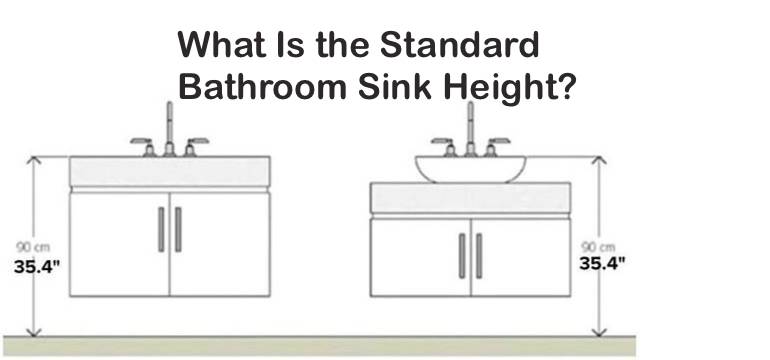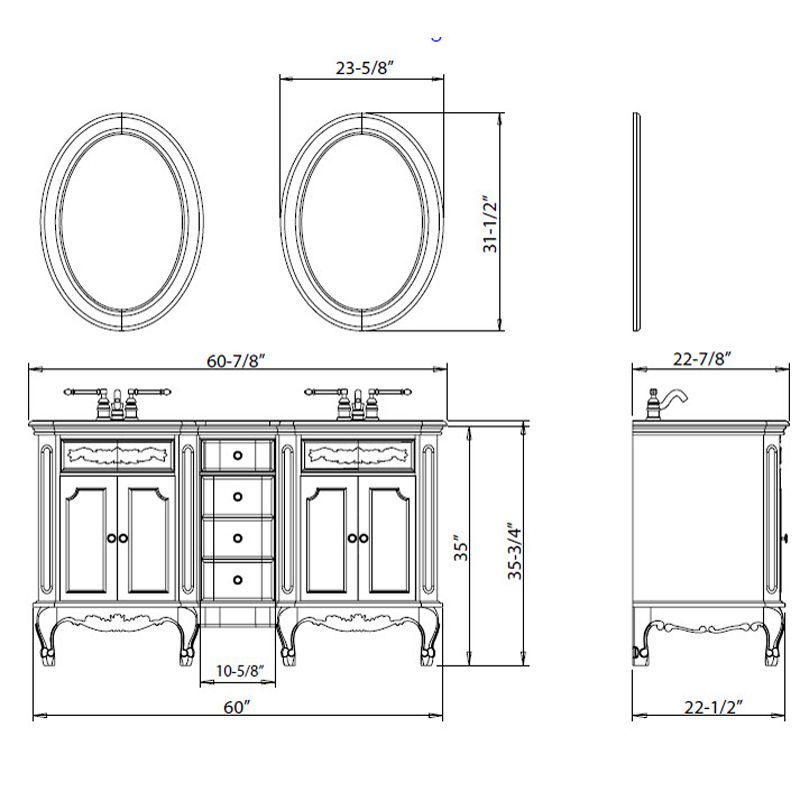Standard Bathroom Vanity Heights

The height of a bathroom vanity is a crucial consideration for both aesthetics and functionality. It influences the overall look of the bathroom and impacts its usability, especially for individuals with mobility limitations. The standard height for bathroom vanities is 34-36 inches, which is generally considered comfortable for most adults.
Standard Vanity Heights for Different Bathroom Types
The standard vanity height can vary depending on the type of bathroom. Here’s a table comparing standard vanity heights for different bathroom types:
| Bathroom Type | Standard Vanity Height (inches) |
|---|---|
| Powder Room | 32-34 |
| Master Bathroom | 34-36 |
| Guest Bathroom | 34-36 |
Advantages of Standard Height Vanities
Using a standard height vanity offers several advantages:
- Accessibility: Standard height vanities are easily accessible for most adults, promoting ease of use and reducing the risk of strain or injury.
- Ergonomics: A standard height vanity allows for comfortable posture while using the sink, preventing back pain and promoting good ergonomics.
- Functionality: A standard height vanity provides ample space for storage and allows for easy access to plumbing fixtures.
Factors Influencing Vanity Height Selection: Typical Bathroom Vanity Height

The height of a bathroom vanity is a crucial factor in determining its functionality and aesthetic appeal. It significantly impacts the overall comfort and usability of the space. Several factors influence the ideal vanity height, ensuring a seamless blend of style and practicality.
Countertop Material Impact on Vanity Height
The material chosen for the countertop can influence the overall vanity height. Thicker countertop materials, such as granite or marble, can add height to the vanity. In contrast, thinner materials like laminate or engineered stone may result in a lower vanity height.
For instance, a vanity with a 2-inch thick granite countertop will be taller than a vanity with a 1-inch thick laminate countertop, even if the vanity cabinets are the same height.
Sink Type and Depth Influence on Vanity Height
The type and depth of the sink significantly impact the overall vanity height. Undermount sinks, which are installed beneath the countertop, typically require a higher vanity to accommodate the sink’s depth. Conversely, vessel sinks, which sit on top of the countertop, can be used with lower vanity heights.
For example, a vanity with an undermount sink will generally require a higher countertop than a vanity with a vessel sink, even if the cabinets are the same height.
User Height and Comfort in Vanity Height Selection
The height of the user is a primary factor in determining the most comfortable vanity height. A vanity that is too high or too low can cause discomfort and strain, particularly for individuals with mobility issues. The ideal vanity height should allow for a comfortable posture while standing at the sink.
For instance, a vanity height of 34 inches is generally recommended for individuals of average height, while a vanity height of 32 inches might be more comfortable for individuals who are shorter.
Vanity Height Considerations for Accessibility

Designing a bathroom that caters to individuals with varying mobility needs is essential for creating an inclusive and comfortable environment. The height of the bathroom vanity plays a crucial role in ensuring accessibility and ease of use. This section explores vanity height recommendations, best practices for incorporating accessibility features, and examples of designs that prioritize user comfort.
Vanity Height Recommendations for Different Mobility Needs
Vanity height recommendations vary depending on the individual’s mobility needs. Here’s a table outlining appropriate vanity heights for different groups:
| Mobility Needs | Recommended Vanity Height (inches) |
|---|---|
| Wheelchair Users | 29-34 |
| Individuals with Limited Mobility | 30-32 |
| Average Height Individuals | 32-36 |
Incorporating Accessibility Features for Improved Usability, Typical bathroom vanity height
Integrating accessibility features into bathroom vanity design can significantly enhance usability for individuals with mobility challenges.
Grab Bars
Grab bars provide essential support and stability, particularly for individuals with balance issues or limited upper body strength.
- Install grab bars on both sides of the vanity, positioned within easy reach.
- Choose grab bars with a diameter of 1.25 inches for optimal grip.
- Ensure the grab bars are securely mounted to the wall studs for maximum support.
Adjustable Shelves
Adjustable shelves offer flexibility and allow users to customize the vanity storage space according to their needs.
- Install adjustable shelves at different heights to accommodate items of varying sizes.
- Use shelves with a smooth, non-slip surface to prevent items from falling.
- Consider using pull-out shelves for easier access to items stored at the back of the vanity.
Examples of Accessible Vanity Designs
Here are some examples of vanity designs that prioritize accessibility and user comfort:
Vanity with a Lower Countertop
A vanity with a lower countertop height, typically between 29-32 inches, is ideal for individuals who use wheelchairs or have limited mobility. This design allows for easy access to the sink and countertop without the need to reach excessively.
Vanity with a Knee Space
A vanity with a knee space provides ample legroom for individuals who use wheelchairs or have difficulty bending their knees. This feature allows for comfortable seating and easy maneuvering.
Vanity with a Built-in Seat
A vanity with a built-in seat offers a convenient and comfortable seating option for individuals who need to sit while using the sink. The seat can be integrated into the vanity design or added as a separate accessory.
Vanity with a Tilt-Out Sink
A vanity with a tilt-out sink allows for easier access to the sink for individuals with limited mobility. The sink can be tilted forward, providing a more accessible position for washing hands and brushing teeth.
The typical bathroom vanity height is around 32-36 inches, providing comfortable access for most individuals. However, when considering a more compact solution, a 30 inch bathroom vanity with drawers can be an attractive option, offering ample storage space within a smaller footprint.
30 inch bathroom vanity with drawers are often available in various styles and finishes, allowing for seamless integration into diverse bathroom designs. While a 30 inch vanity might be slightly lower than the standard height, it can still be comfortable for individuals of average height, particularly if the sink is positioned at a slightly higher elevation.
The typical bathroom vanity height ranges from 30 to 36 inches, allowing for comfortable use and accessibility. However, for those seeking a more luxurious and spacious experience, a 59-inch bathroom vanity, such as those described in this comprehensive guide 59 inch bathroom vanity , offers ample storage and a commanding presence in the bathroom.
This height, exceeding the standard, can enhance the overall aesthetic and functionality of the space, providing a unique and elevated experience.